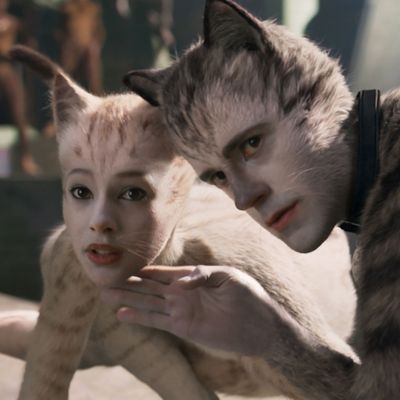
In press interviews about the movie Cats, its stars have consistently brought up the fact that they attended a “cat school” on set, which was apparently a place where they were trained in catlike behaviors and movements in order to reinforce the movie’s grand conceit that, as James Corden put it, “These are people, but they’re cats.” In the final version of the film, with all the digital fur technology applied, you can see evidence of cat schooling at work, in the way the actors sometimes creep along on four legs, or sniff each other when they meet and then nuzzle each other’s necks as a kind of greeting. The experience of watching it is surreally both human and cat.
Whatever happened in cat school, it definitely had a pervasive effect on the actors’ physicality, and so obviously, I had to find out more about it. Thankfully, I was able to get in touch with Sarah Dowling, the movie’s intense and hilarious movement coordinator, who oversaw the cat school and spent, to her estimation, five months closely studying the movements and behaviors of cats, before setting up a system through which she would coach the entire Cats cast on cat behaviors. Somehow, they were all enthusiastic about the idea, too. “It is a crazy concept, if I’m talking to my real friends outside of this world, they’re like, ‘really?’” Dowling said, “and I thought I’d have reticence, but they were all willing to jump in and have a play in this world.”
Before the Choreography, There’s Cat School
“I started research for cat school and rehearsals for cat school before the choreographer came into the room,” Dowling explained. She has a background in performance through Punchdrunk, the theater company responsible for Sleep No More, and has also worked as a movement director on the recent Mary Queen of Scots (including choreographing the execution and birth scenes) and the upcoming new version of Rebecca. When Dowling came onto Cats, director Tom Hooper told her that he wanted the feline nature of the characters to be a thread throughout the movie, even when they are singing or dancing or speaking. She would set up a cat school, therefore, to teach the performers to naturally enact the body language of a cat, so that they could then build the vocal coaching and dance choreography (by Andy Blankenbuehler) on top of that knowledge.
Ian McKellen Learns to Sniff
Dowling set up a multi-step curriculum for teaching actors and dancers how to move like a Jellicle Cat. She started with basic cat anatomy and behavior, teaching people through videos or lectures about the specifics of cat movement. She would then have the actors play as cats and instruct them, for instance, to say hello by coming up to one another and bump noses. “Every single person who’s in the film does that,” Dowling said. They learned how to sit as a cat, or and how to “sniff before they see” — to react to things less with their eyes than with their ears and noses. Ian McKellen was apparently “especially enamored” with this part of the process.
“On the day we learned how cats greet one and other, I was paired with Sir Ian McKellen,” Robbie Fairchild, the former New York City Ballet dancer and Tony nominee who plays the narrator-like Munkustrap, said. “You go four inches away from each other and from each other’s faces and just start smelling, and if you like each other, you tap noses and you rub on each other. I’m four inches away from Gandalf, and we’re there for 15 seconds and then I go for it. I go in and he goes, ‘no, no, no! Not yet, I’m not ready.’” When I relayed that anecdote to Dowling, she laughed. “Ian was really very thorough, hard working in his cat school,” she said. “We did a lot of it with him.”
Once basic cat behaviors were in place, Dowling coached the performers on their individual character’s behavior. As the Cats lore goes, each Jellicle cat has a distinct personality, which Dowling wanted the actors to embrace. She was fine with the way James Corden (Bustopher Jones) and Rebel Wilson (Jennyanydots) “had their own take” on being cat-like, which involved more traditional slapstick physical comedy. “What’s amazing about cats is how unpredictable they are,” Dowling. “What’s amazing about those two people is they’re so surprising, both verbally and physically, and that was very much like a cat trait for me.”
Everyone Needs Cat Practice, Taylor Swift Less So
The more screen time required of a performer in Cats, the more cat coaching they needed. For example, Francesca Hayward, who plays the audience surrogate in Victoria the White Cat, and Fairchild, were “in the room with me for six weeks,” Dowling explained, “We were practicing ‘cat’ for a long, long time. Not every day till 5, but every day we’d check in. Frankie and Robbie were eating their lunch like a cat in the end.”
Some of the movie stars who appear in cats had less time to film, so Dowling modified their lessons. “Everyone had different amounts of time in the room, but the ideal scenario was that we’d get lots of cats to play in the room,” Dowling said, “because it’s important to get a sense of hierarchies and relationships within the group.” Dowling went to Judi Dench’s house with Tom Hooper to teach cat school there. Taylor Swift, meanwhile, was “more of a cat expert than me,” Dowling said, and she had already spent a lot of time thinking about cat behavior. “She came in very equipped to be the most slinky, sultry, sexy feline in the room.”
How Does a Jellicle Cat on Two Legs?
One problem Dowling ran into in the course of cat school: no matter how much the cast trained moving as quickly as possible on four legs (“and we trained bloody long”), they couldn’t move fast enough to make some scenes work. Some two-legged movement was simply an inevitability. (As Jason Derulo put it: “We’re not just regular cats, we’re cat people.”) But by this point, Dowling had “got so far into the logic of the cat” that she felt she needed to devise specific rules for when the cast would employ human-movements rather than straightforward cat play. In the end, she decided that the cats’ physicality would obey a sort of musical logic, as if becoming humanlike (as they would also act while dancing) was a sign of some emotion overtaking them. “If ever needed to run, they needed to go to two feet,” Dowling explained, “so if there was some big urge or instinct to do something strong, they would go to two feet.”
If the fact that Cats operates in a fantasy world let Dowling explain away moments like that, it didn’t stop her from rigorously policing the details of two-legged movement anyway. She taught all the actors to walk moving the same leg and same arm at once, rather than contralaterally, as humans walk. “I don’t know whether any ordinary person would notice,” Dowling said, “but it helps make the language cohesive, within this mad, big group of people.”
Don’t Forget You Have a Tail
Thanks to the magic of digital fur technology, the actors all got tails in the final version of Cats. That meant that, on set, Dowling had to remind them to move as if they had a tail already, even if there was nothing there. “It was literally harnessing the imagination, and getting the imagination to change the physicality,” Dowling said, explaining that she spent a lot of time telling the actors to shift their posture by imagining that their spine extends past them, or reminding them that their tail would counterbalance their weight in a pose. “It was really wild to see our tails for the first time,” Fairchild said. “Because we trained so hard to figure out how to make our spines look natural so that the tail would look natural.”
Dowling also coordinated with the effects team on set, and would speak to them about how a tail or the ears on top of a cats body might be rendered in a scene, to make sure that the actors wouldn’t sit in a way that would make the animation impossible. She also spent a little time in the editing room overseeing how the feline-ish anatomy would be rendered in the final product. “I was in there for a little bit of it,” Dowling said, admitting she had to move on to another project. “If we’d done it all again, I’d be in there [the whole time], but it was in safe hands, Tom was guardian of the cats from that point onwards.”
More From This Series
- Cat Performances, Ranked
- Watch Cats With Us on Instagram Tonight … Please
- Cats Flopped and Then Things Got Interesting





